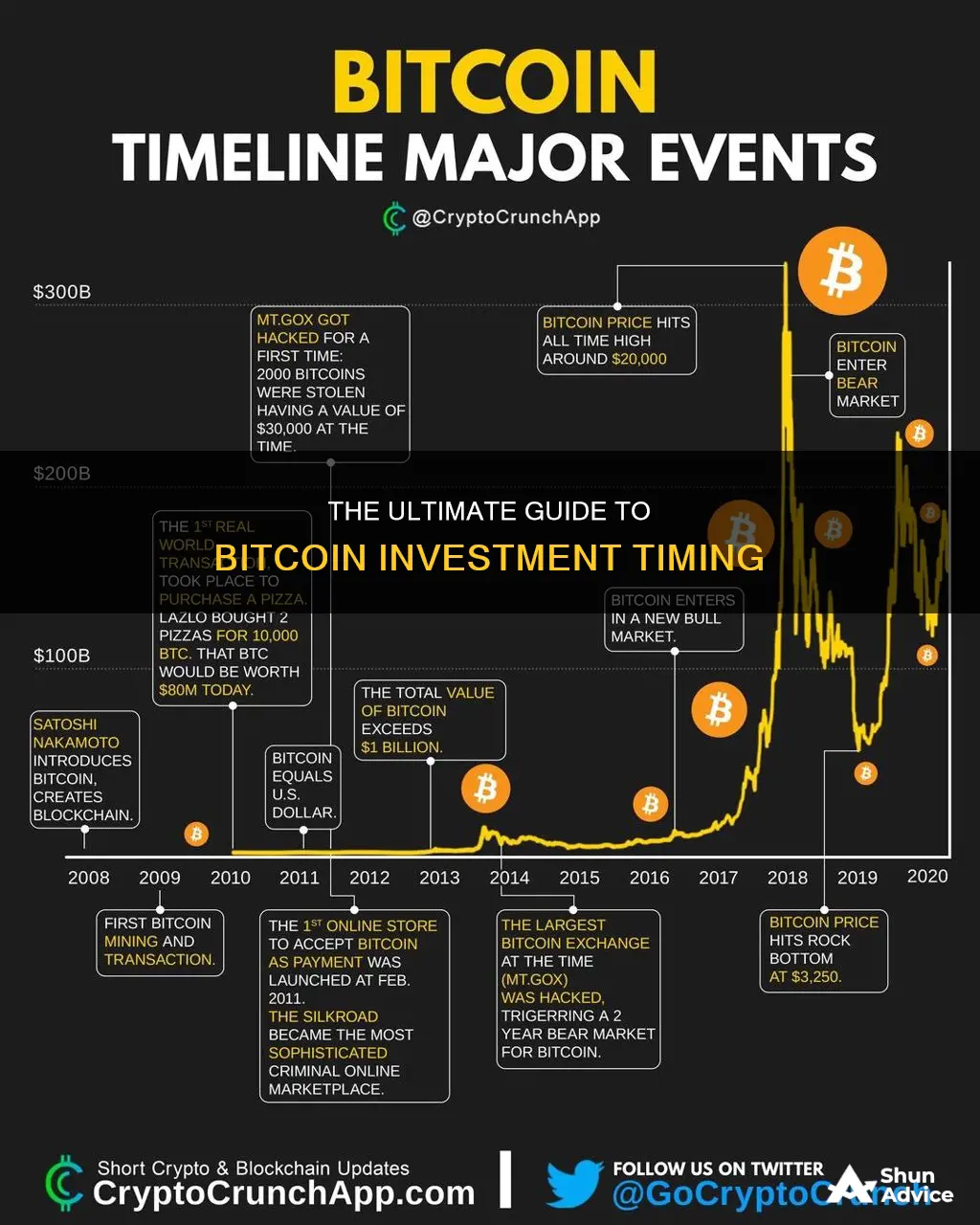
Bitcoin is a cryptocurrency built on blockchain technology, which it uses for both validation and security. It was introduced to the public in 2009 by an anonymous developer or group of developers using the name Satoshi Nakamoto. Bitcoin is prone to price volatility, with wide swings to the upside and downside. The process of investing in Bitcoin is more straightforward than mining it. To invest in Bitcoin, you need to have a cryptocurrency exchange account, personal identification documents, a secure internet connection, a payment method, and a personal digital wallet.
| Characteristics | Values |
|---|---|
| Time to mine 1 Bitcoin | 10 minutes to mine a block, with 3.125 Bitcoin per block. |
| Time to confirm a transaction | 1 hour for 6 block confirmations. |
| Time to invest in Bitcoin | Varies depending on the exchange. |
What You'll Learn

Choosing a crypto-trading service or venue
There are several factors to consider when choosing a crypto-trading service or venue. Here are some key considerations:
- Security and Regulation: Prioritize the security of your funds. Look for services that implement robust security measures such as two-factor authentication (2FA), cold storage wallets, and encryption protocols. Also, ensure the service is compliant with relevant regulatory standards to protect yourself from potential scams or legal issues.
- Reputation and Track Record: Research the reputation and history of the service or venue. Look for user reviews and community feedback, and their record of security breaches. Opt for those with a solid reputation and a proven track record of reliable service.
- Supported Crypto-Assets: Different services support different cryptocurrencies. Ensure the service you choose supports the crypto-assets you intend to trade or invest in. Popular services usually offer a wide range of crypto-assets, including Bitcoin (BTC), Ethereum (ETH), and other major altcoins.
- Liquidity: Liquidity refers to the ease of buying or selling a crypto-asset without significantly impacting its price. Higher liquidity ensures smoother transactions and minimizes the risk of slippage. Choose a service with good liquidity to ensure your orders are executed promptly at fair prices.
- User Interface and Experience: An intuitive and user-friendly interface is essential, especially for beginners. Look for services with a clean and easy-to-navigate interface suitable for your level of experience. Additionally, check if they offer a mobile app for trading on the go.
- Fees: Compare the fee structures of different services. Services charge fees for deposits, withdrawals, and trading activities. Be cautious of hidden fees or excessively high charges as they can eat into your profits.
- Customer Support: Prompt and reliable customer support is crucial, especially when you encounter issues or have queries. Check if the service provides multiple support channels, such as live chat, email, or phone.
- Geographical Restrictions: Some services have geographical restrictions. Ensure the service you choose operates in your country or region and complies with local regulations.
- Trading Tools and Features: If you're an advanced trader, look for services that offer a variety of trading tools and features such as charting tools, order types, stop-loss options, and margin trading. Ensure the service supports your specific trading requirements and facilitates your trading strategy.
- Transparency and Reporting: Transparency is vital in the crypto world. Look for services that provide regular reports on trading volume and audits. Transparent services inspire trust and enable you to make informed investment decisions.
Coinbase Crypto Investment: Best Bets for Your Buck
You may want to see also

Connecting your exchange to a payment option
After choosing a crypto-trading service or venue, the next step is to connect your exchange to a payment option. Depending on the exchange, you may be required to provide personal identification, such as a driver's license or Social Security card, as well as information about your employer and source of funds. This process is similar to setting up a typical brokerage account.
At most exchanges, you have the option to connect your bank account directly or link it to a debit or credit card. While it is possible to use a credit card to purchase cryptocurrency, it is important to consider the potential impact of cryptocurrency price volatility combined with a credit card's interest charges. Additionally, while Bitcoin is legal in the US, some banks may question or even stop deposits to crypto-related sites or exchanges.
It is worth noting that fees vary for deposits made via different methods, such as bank accounts, debit cards, or credit cards. Exchanges also typically charge fees per transaction. Therefore, it is essential to carefully review the associated fees before proceeding.
Choosing a payment method
When it comes to acquiring Bitcoin, there are several payment methods available. Here are some of the most common options:
- Bank transfers: This method involves transferring funds from your bank account to a cryptocurrency exchange or broker to purchase Bitcoin. It is generally considered one of the safest and most secure ways to buy Bitcoin.
- Credit or debit cards: Using a credit or debit card to buy Bitcoin is a convenient option, especially if you want to make a small purchase. However, it is important to be aware of the potential fees and interest charges associated with this payment method.
- PayPal: PayPal allows you to connect your bank account or debit card to purchase Bitcoin. It also enables you to use the balance in your PayPal account to buy cryptocurrencies from third-party providers. Additionally, you can use PayPal to directly buy Bitcoin, Ethereum, Litecoin, and Bitcoin Cash.
- Crypto debit cards: These cards, such as the BitPay Card, allow you to load them with cryptocurrency and spend it like cash anywhere that accepts Mastercard. Crypto debit cards offer a convenient and flexible way to use your cryptocurrency holdings for everyday purchases.
- P2P (peer-to-peer) payments: P2P payments are a direct way to send or receive cryptocurrency between users. All you need is the recipient's crypto wallet address to initiate the transaction.
- Bitcoin ATMs: These ATMs allow you to insert cash and use it to purchase Bitcoin, which is then transferred to your online wallet. However, it is important to note that Bitcoin ATM transactions typically incur higher fees compared to other options.
Declare Bitcoin Income: Taxes and You
You may want to see also

Placing an order
Once you've chosen an exchange and set up your wallet, it's time to place your order. Here's a step-by-step guide on how to place an order for Bitcoin:
- Choose a Crypto Exchange: Select a reputable and secure cryptocurrency exchange such as Coinbase, Binance, Kraken, or Bybit. These platforms provide an interface for buying and selling Bitcoin.
- Create an Account: Sign up for an account on your chosen exchange by providing your personal information, including your name, email address, and setting up a password. Some exchanges may also require additional verification steps, such as proof of ID and address.
- Deposit Funds: Fund your account by connecting it to your bank account or using a credit or debit card. Different exchanges may offer different payment methods, so choose one that suits your preferences. Make sure to review any associated fees and charges before depositing.
- Select Bitcoin (BTC): Navigate to the market or trading section of the exchange and look for Bitcoin, usually denoted as "BTC." You may need to search for it by name or symbol.
- Place a Buy Order: Decide on the amount of Bitcoin you want to purchase. You can buy a whole Bitcoin or a fraction of it, as Bitcoin is divisible to eight decimal places. Specify the amount you want to buy and place your buy order.
- Review the Order Details: Before finalizing the order, carefully review the details, including the amount of Bitcoin, the current market price, and any associated fees or charges. Different exchanges may have varying fee structures, so make sure you understand the costs involved.
- Confirm the Order: Once you are satisfied with the order details, confirm the transaction. Your exchange will then process the purchase, and the Bitcoin will be deposited into your crypto wallet.
Note: It is essential to do your research and understand the risks associated with investing in Bitcoin. The value of Bitcoin can be highly volatile, and there are no guarantees of profits. Always invest within your risk tolerance and consult with a financial professional if needed.
Understanding Bitcoin: Do Investors Really Get It?
You may want to see also

Safe storage
- Cold Storage: Cold storage refers to keeping your Bitcoins offline, which provides an extra layer of security. This method involves storing your Bitcoins in a secure location without exposing the private keys that control them to the internet. Cold storage can be achieved through hardware wallets, such as TREZOR, or by creating a cold storage wallet using specialised software like BitKey. Hardware wallets are designed to be highly resistant to common online threats such as viruses and hackers. When dealing with large amounts of Bitcoin, cold storage is often a necessary security precaution.
- Secure Offline Computer: To enhance the security of your Bitcoin storage, consider setting up a dedicated offline computer. This involves using an old laptop or phone, wiping all data, and installing only an operating system and a Bitcoin wallet. By keeping this device offline and physically separated from your online computer, you minimise the risk of remote hacking attempts. Ensure that the offline device has Bitcoin wallet software installed, and generate a wallet with a seed phrase written down on paper or another medium.
- Watch-Only Wallet: You can create a watch-only wallet on your online computer by obtaining the master public key from your offline wallet. This type of wallet allows you to receive money, monitor transactions, and check your balance without exposing your private keys. When you need to spend Bitcoins, the watch-only wallet creates an unsigned transaction, which is then transferred to the offline computer for verification and signing.
- Data Transfer Methods: When transferring data between your offline and online computers, there are several methods to choose from. You can use a USB flash drive, QR codes, or transcribe the data by hand. Each method has its advantages and disadvantages in terms of speed, convenience, and security. For example, USB flash drives are fast and convenient, but they have an attack surface that could be exploited. QR codes are believed to have a smaller attack surface, but they have size limitations for larger Bitcoin transactions. Transcribing data by hand is the slowest method but eliminates the security risks associated with digital transfer methods.
- Private Key Backup: It is crucial to back up your private keys securely. One recommended method is to use seed phrases, which can be written on paper or metal. Seed phrases use natural language words, providing excellent error correction capabilities. Even if a few letters are missing or unreadable, the correct word can often be deduced. Additionally, consider storing your backups in multiple secure locations, such as safe deposit boxes or distributed among trusted individuals.
- Hot Wallets: While not ideal for long-term storage, hot wallets can be used for small amounts of cryptocurrency or for active trading. Hot wallets are online wallets, typically in the form of apps on internet-connected devices like computers or phones. They offer convenience but come with higher security risks. Ensure that you enable strong passwords, two-factor authentication, and safe internet browsing practices when using hot wallets.
Remember that the security of your Bitcoin investment is of utmost importance. By following these safe storage practices, you can help protect your Bitcoin from theft and other potential threats.
Free Ways to Earn Bitcoin: No Investment Needed
You may want to see also

Public interest and media coverage
Bitcoin is a decentralized digital currency that can be bought, sold, and exchanged directly without an intermediary like a bank. Its creator, Satoshi Nakamoto, described the need for "an electronic payment system based on cryptographic proof instead of trust." Every Bitcoin transaction is recorded on a public ledger, making it hard to reverse and difficult to fake.
Bitcoin's value is influenced by public opinion and media coverage. For instance, in 2021, a tweet from Tesla's Elon Musk caused Bitcoin's price to drop by 30% in a single day, wiping about $365 billion off the cryptocurrency market.
Bitcoin's price movements are prone to volatility and can be influenced by news events. For example, expectations for the approval of Bitcoin Spot ETFs in early 2024 pushed its price into the mid-$40,000s. After the ETFs were approved, Bitcoin's price climbed to over $50,000.
The public interest in Bitcoin is driven by its potential as an investment vehicle and a hedge against inflation. Its price has experienced dramatic highs and lows, making it an attractive but risky prospect for investors.
The media eagerly covers Bitcoin's price movements, with financial media outlets like Forbes, Investopedia, and NerdWallet providing in-depth analyses of its performance and future prospects. The approval of spot Bitcoin ETFs by the SEC in 2024 was a significant development that generated extensive media coverage, as it made it easier for traditional investors to access Bitcoin.
The public and media interest in Bitcoin is driven by its status as the first and most well-known cryptocurrency, with a market cap of over $1 trillion as of June 13, 2024. Its price movements, volatility, and potential as an investment or hedge fuel ongoing coverage and public fascination.
Should You Invest in Bitcoin?
You may want to see also
Frequently asked questions
Investing in Bitcoin is quite simple. If you're purchasing through a stockbroker, it's a similar process to buying shares of a company. Otherwise, you may need to gather your personal information and bank account details. The first step is to join an exchange such as Coinbase Global or Binance. Once you've chosen an exchange, you'll need a crypto wallet, which can be a "hot" wallet or a "cold" wallet. With your wallet configured, you can then place your order.
The amount of time it takes to mine 1 Bitcoin varies based on many factors, such as the Bitcoin network's current mining difficulty. Mining is a competitive process, and the more miners there are, the higher the difficulty. On average, it takes about 10 minutes to mine a block, and the network releases a fixed amount of Bitcoin as a block reward. However, due to the massive amount of computing power required, it's almost impossible for one miner to receive all of the reward.
The best way to invest in Bitcoin depends on your individual circumstances and risk tolerance. It's important to remember that Bitcoin is a high-risk asset, and you should never invest more money than you are willing to lose. You may want to consider investing in other cryptocurrencies or exploring other blockchain-based investments to hedge your portfolio.
Bitcoin's value is influenced by several factors, including supply and demand, media coverage and public interest, government legislation, and the wider crypto market. For example, China's 2021 ban on cryptocurrency caused a sharp drop in Bitcoin's price.







